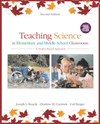 |  Teaching Children Science: A Project-Based Approach, 2/e Joe Krajcik,
University of Michigan - Ann Arbor
Charlene Czerniak,
University of Toledo
Carl Berger,
University of Michigan - Ann Arbor
Why and How Should I Teach Science to Children?
Web LinksThird International Mathematics and Science Study (TIMSS)
(http://nces.ed.gov/TIMSS)
This site provides the results of the Third International Mathematics and Science Study (TIMSS), which compared the achievement of U.S. students in math and science to that of students in dozens of other countries. The first study was conducted in 1995, and a repeat study was conducted in 1999. |
 |  |  | National Science Education Standards
(http://www.nap.edu/books/0309053269/html)
This site for the National Academy Press is a Web site search engine for publications by the National Science Education Standards. These publications outline programs to improve science literacy. |
 |  |  | Project 2061
(http://www.project2061.org/)
Project 2061 is run by the American Association for the Advancement of Science. Its goal is to reform the teaching of K-12 science, mathematics, and technology. To achieve this goal it designs educational products and conducts activities and workshops. |
 |  |  | Benchmarks
(http://www.project2061.org/tools/benchol/bolframe.htm)
This site consists of 16 Benchmarks dealing with the teaching of science, mathematics, and technology. Each Benchmark sets goals that students should achieve at specific grade levels. |
 |  |  | National Science Teachers Association (NSTA)
(http://www.nsta.org)
Teachers can go to the Web site for the NSTA to see lists of events relating to science teaching, find cross-links to relevant news stories, and order journals relating to science teaching. The site also has resources for students. |
|



 2003 McGraw-Hill Higher Education
2003 McGraw-Hill Higher Education